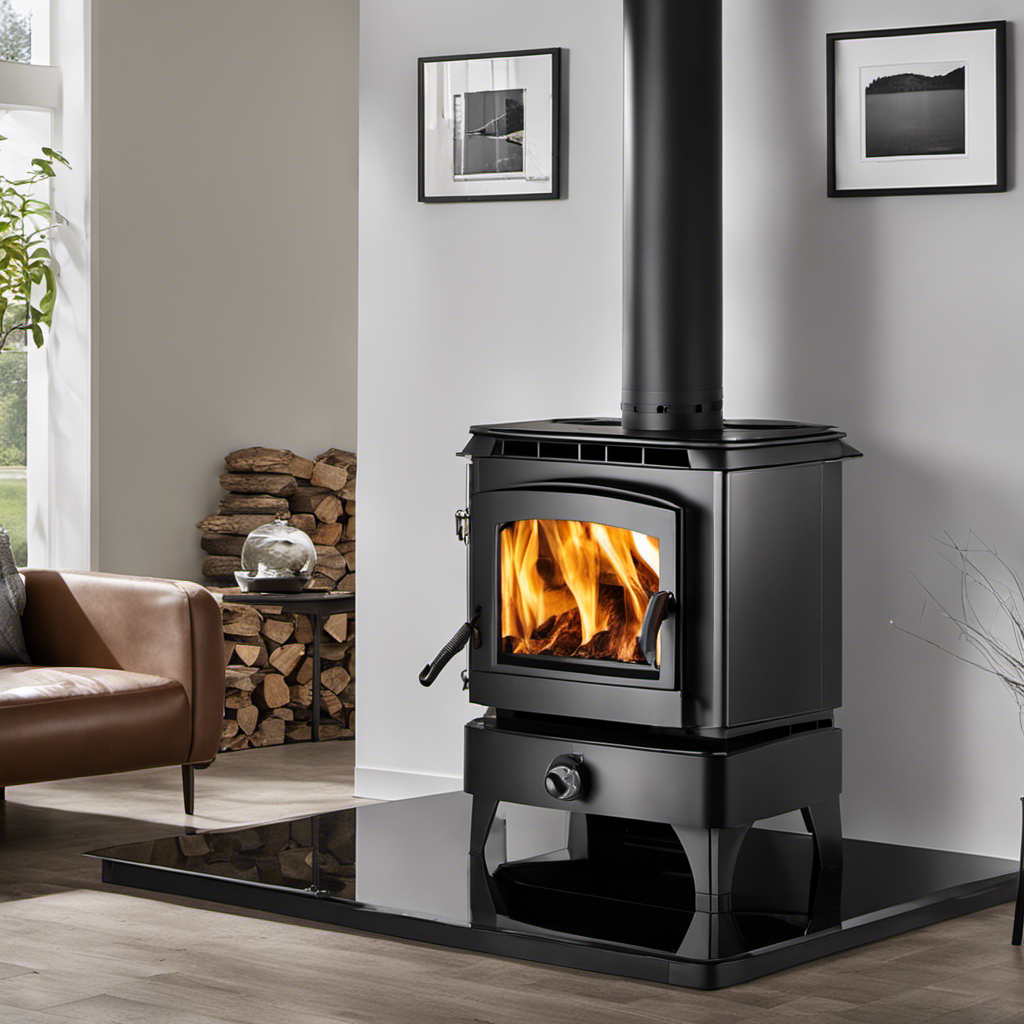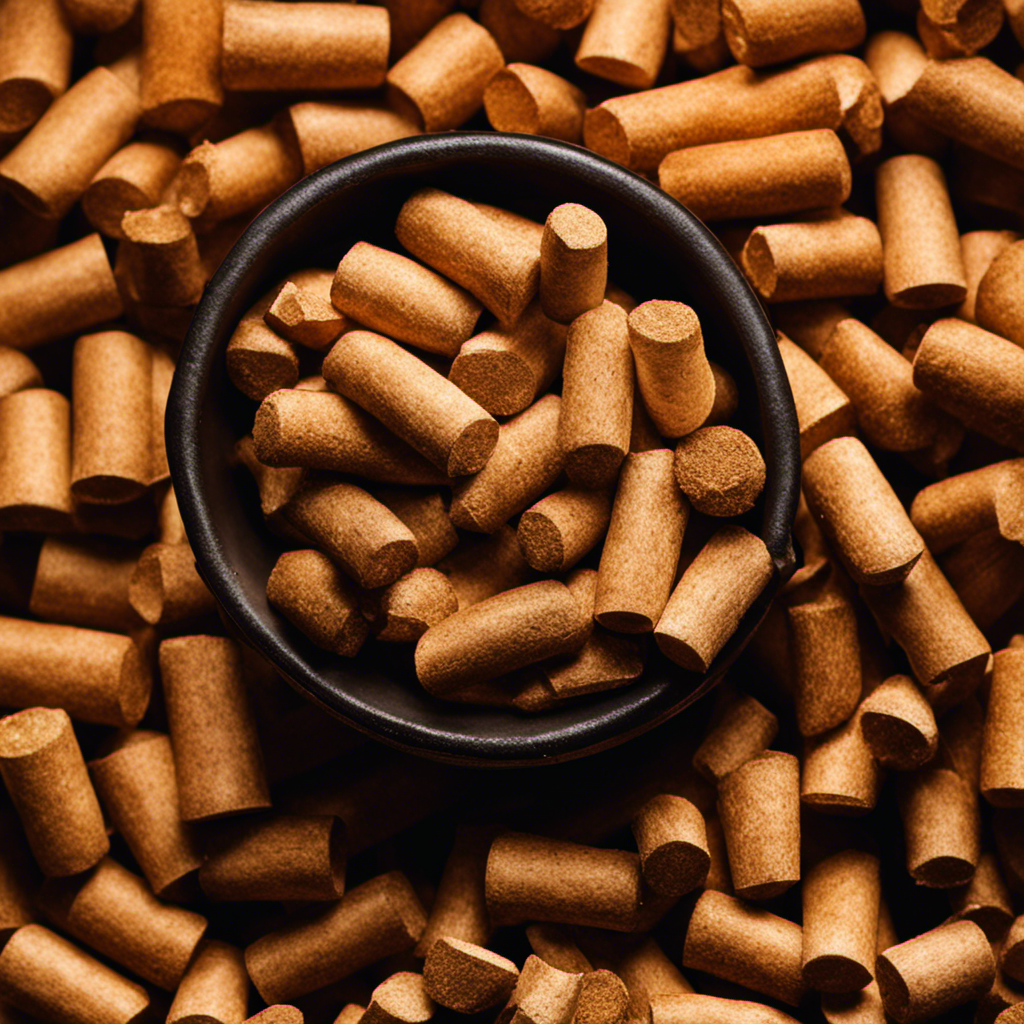I’ve always been fond of the cozy warmth provided by my wood pellet stove, but as time goes by, the glass often gets covered in persistent stains and residues. Consequently, I’ve mastered effective methods for cleaning the glass on a wood pellet stove.
In this article, I’ll share my knowledge and expertise on gathering the necessary supplies, preparing the stove for cleaning, and using simple household solutions to remove those pesky stains.
Get ready to enjoy a clear view of those dancing flames once again!
Key Takeaways
- Regular cleaning of wood pellet stove glass maintains efficiency and functionality
- Using appropriate cleaning tools and solutions ensures efficient removal of stains and residue
- Proper cleaning technique, such as using a specialized glass cleaner and gentle circular motions, helps maintain pristine glass
- Safety precautions, such as wearing protective gloves and goggles and using non-toxic cleaners, should be followed for a safe and effective cleaning process.
Understanding the Importance of Clean Wood Pellet Stove Glass
I understand the importance of keeping my wood pellet stove glass clean. Regular glass cleaning is essential for maintaining the efficiency and functionality of my wood pellet stove. When the glass is dirty, it can obstruct the view of the flames, making it difficult to monitor the combustion process. This can lead to poor performance and wasted fuel.
One of the benefits of regular glass cleaning is that it allows me to enjoy the beautiful, dancing flames of my wood pellet stove. A clean glass enhances the visual appeal of the fire, creating a cozy and inviting atmosphere in my home. Additionally, clean glass ensures that the maximum amount of heat radiates into the room, keeping me warm and comfortable during the colder months.
However, it’s important to avoid common mistakes when cleaning wood pellet stove glass. Firstly, using abrasive materials or harsh chemicals can damage the glass surface. It’s recommended to use a soft cloth or sponge and a mild glass cleaner specifically designed for wood stoves.
Secondly, cleaning the glass while it’s still hot can cause it to crack or shatter. It’s crucial to wait until the stove has completely cooled down before attempting to clean the glass.
Gathering the Necessary Supplies for Cleaning
When it comes to gathering the necessary supplies for cleaning, I always make sure to have everything I need within arm’s reach.
This includes essential cleaning tools such as microfiber cloths, a mild cleaning solution, and a pair of gloves for protection.
Essential Cleaning Tools
To effectively clean wood pellet stove glass, one must have essential cleaning tools such as a microfiber cloth and a glass cleaner. These tools are crucial for achieving a spotless and streak-free finish on the glass.
Here are four reasons why these cleaning tools are essential:
-
Microfiber cloth: The soft and absorbent fibers of a microfiber cloth gently remove dirt, grime, and soot from the glass without scratching it.
-
Glass cleaner: A specialized glass cleaner is formulated to cut through tough stains and residue, leaving the glass crystal clear and shiny.
-
Cleaning equipment: Having the right cleaning tools ensures efficiency and effectiveness in removing stubborn stains and build-up on the glass.
-
Cleaning solutions: Using the appropriate cleaning solutions helps to break down and dissolve the greasy residue commonly found on wood pellet stove glass.
Now that we’ve the necessary cleaning tools, let’s move on to the proper cleaning techniques to ensure a pristine and well-maintained wood pellet stove glass.
Proper Cleaning Techniques
Using a microfiber cloth and glass cleaner, I gently wipe away dirt and grime to achieve a crystal clear and shiny finish.
When it comes to cleaning the glass on a wood pellet stove, it’s important to establish a regular cleaning frequency. The frequency will depend on how often you use the stove, but a general rule of thumb is to clean the glass at least once a week. This will prevent the buildup of soot and make the cleaning process easier.
To remove soot, I recommend using a specialized glass cleaner that’s designed to cut through the tough residue. Spray the cleaner onto the cloth and then gently scrub the glass in circular motions. Rinse the cloth and wipe away any excess cleaner.
With regular cleaning and proper technique, you can keep your wood pellet stove glass looking pristine.
Preparing the Wood Pellet Stove for Cleaning
Before beginning the cleaning process, it’s important to properly prepare the wood pellet stove.
First, ensure that the stove is turned off and completely cooled down.
Next, remove any ashes or debris from the stove and clear the surrounding area to prevent any potential hazards.
Finally, gather all the necessary cleaning supplies and make sure they’re easily accessible.
Taking these steps will ensure a safe and efficient cleaning process.
Safety Precautions When Cleaning Wood Stove Glass
I always make sure to wear protective gloves and goggles when cleaning the wood stove glass. Safety is a top priority when handling cleaning products and dealing with potentially harmful substances.
Here are four important safety measures to keep in mind while cleaning your wood stove glass:
-
Ventilation: Ensure that the area is well-ventilated to prevent the accumulation of fumes and chemicals. Open windows or use exhaust fans if necessary.
-
Non-toxic cleaners: Choose cleaning products that are specifically designed for wood stove glass. Avoid using harsh chemicals that can damage the glass or release harmful fumes.
-
Proper storage: Keep all cleaning products securely stored in a designated area away from children and pets. Follow the instructions on the product labels for safe handling and storage.
-
Protective gear: Always wear protective gloves and goggles to shield your hands and eyes from any potential hazards. This will help minimize the risk of injuries or chemical exposure.
Recommended Cleaning Products
When selecting cleaning products for my wood stove glass, I always look for options that are specifically designed for this purpose. It’s important to use the right products to ensure that the glass is cleaned effectively without causing any damage. While there are many natural cleaning alternatives available, I prefer to use professional cleaning services for my wood stove glass. These services have the expertise and specialized equipment to clean the glass thoroughly and safely. They also use products that are specifically formulated for removing soot and stains from wood stove glass. This ensures that my glass is left sparkling clean and free from any residue. Additionally, professional cleaning services save me time and effort, allowing me to enjoy the warmth and ambiance of my wood stove without worrying about the cleaning process.
| Natural Cleaning Alternatives | Professional Cleaning Services |
|---|---|
| Vinegar and Water Solution | Specialized Glass Cleaners |
| Baking Soda Paste | High-Quality Microfiber Cloth |
| Lemon Juice | Soft-bristle Brush |
Step-By-Step Cleaning Process
To begin, I gather all the necessary cleaning supplies and prepare my work area. Cleaning the glass on a wood pellet stove may seem like a daunting task, but with the right approach, it can be done effectively and efficiently. Here is a step-by-step guide to help you clean your wood pellet stove glass:
- Use a glass cleaner specifically designed for wood stoves to avoid any damage.
- Spray the cleaner onto the glass surface and let it sit for a few minutes to loosen any grime.
- Gently scrub the glass using a non-abrasive sponge or cloth, making sure to remove any stubborn stains.
- Finally, wipe the glass clean with a soft, lint-free cloth for a streak-free finish.
Understanding the benefits of regularly cleaning your wood pellet stove glass, such as improved visibility and increased efficiency, can motivate you to maintain a cleaning routine. Avoiding common cleaning mistakes, like using harsh chemicals or abrasive materials, will ensure the longevity and performance of your stove.
Now, you can enjoy a clear view of the beautiful flames in your wood pellet stove.
Using Simple Household Solutions to Remove Stubborn Stains
Removing stubborn stains from wood pellet stove glass can be accomplished using simple household solutions.
As an expert in maintaining and cleaning wood pellet stoves, I’ve discovered several effective household alternatives for removing these challenging stains.
One of the most reliable solutions is a mixture of vinegar and water. Simply combine equal parts of white vinegar and water in a spray bottle, and generously spray the solution onto the stained areas of the glass. Allow it to sit for a few minutes, then wipe away the stains using a soft cloth or sponge.
For more stubborn stains, you can create a paste using baking soda and water. Apply the paste to the stains and let it sit for about 15 minutes before scrubbing gently with a non-abrasive sponge.
Another effective method is using a commercial glass cleaner specifically formulated for wood stove glass. These cleaners often contain ingredients like ammonia, which effectively break down and remove stubborn stains.
Whichever method you choose, be sure to follow the instructions carefully and always wear gloves to protect your skin.
With these simple household alternatives, you can easily remove stubborn stains from your wood pellet stove glass, keeping it clean and clear for optimal performance and enjoyment.
Techniques for Safely Cleaning the Glass Surface
As an expert in maintaining and cleaning wood pellet stoves, I’ve found that safety is a top priority when it comes to cleaning the glass surface. Taking the necessary safety measures ensures that you can effectively clean your wood pellet stove glass without any accidents or damages. Here are four important safety measures to keep in mind:
-
Wear protective gloves: Cleaning products can be harsh and irritate the skin. Always wear gloves to protect your hands from any potential harm.
-
Use a non-toxic cleaner: Many commercial cleaners contain harmful chemicals that can release toxic fumes when heated. Opt for eco-friendly and non-toxic products to ensure the safety of your household.
-
Ventilate the area: Proper ventilation is crucial when cleaning the glass surface. Open windows or turn on fans to remove any fumes or airborne particles.
-
Allow the stove to cool down: Before cleaning, make sure the stove has cooled down completely. Cleaning a hot glass surface can lead to burns and injuries.
By following these safety measures, you can effectively and safely clean your wood pellet stove glass.
Now let’s move on to the next section, where I’ll share tips on maintaining and preventing future build-up on the glass surface.
Maintaining and Preventing Future Build-up on Wood Pellet Stove Glass
Maintaining the cleanliness and preventing future build-up on the glass surface of my wood pellet stove is crucial for its optimal performance. Not only does regular cleaning prevent residue build up, but it also ensures clear visibility of the flames, adding to the aesthetic appeal of the stove. To effectively maintain and prevent build-up, I follow a simple cleaning routine.
| Cleaning Step | Frequency | Tools Required |
|---|---|---|
| Wipe Down | Weekly | Microfiber cloth, glass cleaner |
| Deep Clean | Monthly | Glass cleaner, scraper, microfiber cloth |
In my weekly cleaning routine, I use a microfiber cloth and a glass cleaner specifically formulated for stove glass. I gently wipe down the glass surface to remove any dirt or dust particles. This helps to maintain clear visibility and prevent any residue build up.
For a more thorough cleaning, I perform a deep clean on a monthly basis. I start by applying the glass cleaner to the surface and letting it sit for a few minutes. Then, using a scraper, I carefully remove any stubborn residue or build-up. Finally, I wipe down the glass with a microfiber cloth to ensure a streak-free finish.
Can the Cleaning Method for Wood Pellet Stove Glass Help with Replacing the Glass in an Enviro Mini Wood Pellet Stove?
When it comes to replacing glass wood pellet stove, the cleaning method for wood pellet stove glass can make the process much easier. Regular cleaning and maintenance can help prevent the glass from becoming damaged and make replacing the glass in an Enviro Mini wood pellet stove a smoother task.
Can Cleaning the Wood Pellet Stove Glass Help Prevent the Need for Replacement?
Cleaning the wood pellet stove glass regularly can significantly reduce the chances of needing a replacing glass wood stove. By removing built-up residue and soot, you can maintain the glass’s integrity and prevent the need for costly replacements. Regular maintenance can extend the lifespan of your wood pellet stove.
Frequently Asked Questions
Can I Use Regular Glass Cleaner to Clean the Wood Pellet Stove Glass?
I wouldn’t recommend using regular glass cleaner to clean the wood pellet stove glass. There are alternative cleaning methods that are more suitable for this specific type of glass.
Natural cleaning solutions can be a good option, but they also have their pros and cons. It’s important to consider the specific needs of wood pellet stove glass when choosing the right cleaning method.
How Often Should I Clean the Glass on My Wood Pellet Stove?
Cleaning the glass on my wood pellet stove is an essential task to maintain its efficiency. To prevent soot buildup, I clean the glass regularly. By doing this, I ensure that my stove operates at its best and that the glass remains clear for a better view of the flames.
To maintain the cleanliness of the glass, I follow certain tips like using a specialized glass cleaner and avoiding abrasive materials. These simple steps make a significant difference in keeping the glass spotless.
Is It Safe to Use Abrasive Cleaners or Tools on the Glass Surface?
Using abrasive cleaners on glass surfaces can have both pros and cons. While they can effectively remove tough stains and grime, they may also scratch or damage the glass.
To properly maintain and care for glass surfaces in a wood pellet stove, it’s recommended to use non-abrasive cleaners and soft, lint-free cloths.
Regular cleaning and gentle handling will help preserve the clarity and integrity of the glass, ensuring a safe and clean environment for your stove.
What Are Some Alternative Methods for Removing Stubborn Stains on the Glass?
When it comes to removing stubborn stains on glass, there are a few alternative methods you can try.
One popular option is using vinegar or other natural cleaning solutions. These solutions can be effective in breaking down the stains and making them easier to remove. However, it’s important to note that vinegar may not work on all types of stains and it may leave a strong smell.
It’s always a good idea to test a small area first before applying it to the entire glass surface.
Can I Use Vinegar or Other Natural Cleaning Solutions to Clean the Glass on My Wood Pellet Stove?
Yes, you can use vinegar as a natural cleaning alternative to clean the glass on your wood pellet stove. Vinegar is known for its cleaning properties and can effectively remove dirt and grime from the glass surface.
However, it’s important to note that vinegar may leave a strong odor behind and may not be as effective on stubborn stains. It’s always a good idea to test a small area first and consider other cleaning options if needed.
Conclusion
After understanding the importance of clean wood pellet stove glass and gathering the necessary supplies, preparing the stove for cleaning is crucial.
By using simple household solutions and applying safe cleaning techniques, you can easily remove stubborn stains and maintain the glass surface.
By following these steps, you can ensure a clean and efficient wood pellet stove, preventing future build-up and ensuring a cozy and enjoyable atmosphere in your home.











